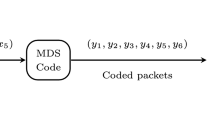Abstract
Fractional repetition codes (FRCs) are a special family of storage codes with the repair-by-transfer property in distributed storage systems. Constructions of FRCs are naturally related to combinatorial designs, graphs, and hypergraphs. In this paper, we consider an extremal problem on regular graphs related to FRCs where each packet is stored on \(\rho =2\) nodes. The problem asks for the minimum number of vertices in an \(\alpha \)-regular graph such that any k vertices induce at most \(\delta \) edges, where \(\alpha \), k, and \(\delta \) are given. Such a problem is closely related to (and can be seen as a generalization of) the classical cage problem, and its solution indicates the minimum number of nodes in an FRC-based distributed storage system. In addition, we further consider FRCs with \(\rho \ge 3\) and generalize the extremal problem to a linear hypergraph version.



Similar content being viewed by others
Notes
Note that if p is adjacent to exactly four vertices among the \(v_i\)-parts, then we can further deduce that the adjacency of p can only be of three forms: adjacent to two vertices from the \(v_1\)-part and two vertices from the \(v_3\)-part, adjacent to two vertices from the \(v_2\)-part and two vertices from the \(v_4\)-part, or adjacent with one vertex from each of the four parts. This argument will also be use in the next two corollaries.
References
Allen P., Keevash P., Sudakov B., Verstraëte J.: Turán numbers of bipartite graphs plus an odd cycle. J. Comb. Theory B 106, 134–162 (2014).
Aydinian H., Boche H.: Fractional repetition codes based on partially ordered sets. In: Proc. IEEE Information Theory Workshop (ITW), pp. 51–55 (2017).
Biggs N.: Algebraic Graph Theory, 2nd edn Cambridge University Press, Cambridge (1993).
Bondy J.A., Murty U.S.R.: Graph Theory. Springer, New York (2008).
Brouwer A.E., Cohen A.M., Newmeier A.: Distance Regular Graphs. Springer, Berlin (1989).
Colbourn C.J., Dinitz J.H.: Handbook of Combinatorial Designs. Discrete Mathematics and Its Applications, 2nd edn. Chapman & Hall/CRC, Boca Raton (2007).
Dimakis A.G., Godfrey P.B., Wainwright M.J., Ramchandran K.: Network coding for distributed storage systems. IEEE Trans. Inf. Theory 56(9), 4539–4551 (2010).
El Rouayheb S., Ramchandran K.: Fractional repetition codes for repair in distributed storage systems. In: Proc. 48th Annual Allerton Conference on Communication, Control, and Computing, pp. 1510–1517 (2010).
Ellis D., Linial N.: On regular hypergraphs of high girth. Electron. J. Comb. 21 (2014).
Etzion T.: Regular graphs with forbidden subgraphs of \(K_n\) with \(k\) edges. Int. J. Inf. Coding Theory 4(2–3), 145–158 (2017).
Exoo G., Jajcay R.: Dynamic cage survey. Electron. J. Comb., Dynamic Survey DS16 (2013).
Fu H., Huang K., Rodger C.: Connectivity of cages. J. Graph Theory 24(2), 187–191 (1997).
Gao G., Chang A.: A linear hypergraph extension of Turán’s theorem. Electron. J. Comb. 29, 4 (2022).
Hoffman A.J., Singleton R.R.: On Moore graphs with diameter \(2\) and \(3\). IBM J. Res. Dev. 4(5), 497–504 (1960).
Hou H., Lee P.P., Shum K.W., Hu Y.: Rack-aware regenerating codes for data centers. IEEE Trans. Inf. Theory 65(8), 4730–4745 (2019).
Hu Y., Lee P.P., Zhang X.: Double regenerating codes for hierarchical data centers. In: Proc. IEEE International Symposium on Information Theory (ISIT), pp. 245–249 (2016).
Koo J.C., Gill J.T.: Scalable constructions of fractional repetition codes in distributed storage systems. In: Proc. 49th Annual Allerton Conference on Communication, Control, and Computing, pp. 1366–1373 (2011).
Olmez O., Ramamoorthy A.: Fractional repetition codes with flexible repair from combinatorial designs. IEEE Trans. Inf. Theory 62(4), 1565–1591 (2016).
Pawar S., Noorshams N., El Rouayheb S., Ramchandran K.: DRESS codes for the storage cloud: simple randomized constructions. In: Proc. IEEE International Symposium on Information Theory (ISIT), pp. 2338–2342 (2011).
Ramkumar V., Balaji S.B., Sasidharan B., Vajha M., Krishnan M.N., Kumar P.V.: Codes for distributed storage. Found. Trends Commun. Inf. Theory 19(4), 547–813 (2022).
Rashmi K.V., Shah N.B., Kumar P.V., Ramchandran K.: Explicit construction of optimal exact regenerating codes for distributed storage. In: Proc. 47th Annual Allerton Conference on Communication, Control, and Computing, pp. 1243–1249 (2009).
Robertson N.: The smallest graph of girth 5 and valency 4. Bull. Am. Math. Soc. 70(6), 824–825 (1964).
Silberstein N., Etzion T.: Optimal fractional repetition codes based on graphs and designs. IEEE Trans. Inf. Theory 61(8), 4164–4180 (2015).
Timmons C.: On \(r\)-uniform linear hypergraphs with no Berge-\(K_{2, t}\). Electron. J. Comb. 24(4), 4–34 (2017).
Yang H., Zhang Y.: On an extremal problem of regular graphs related to fractional repetition codes. In: Proc. IEEE International Symposium on Information Theory (ISIT), pp. 1566–1571 (2022).
Zhu B., Shum K.W., Li H., Anta A.F.: On the duality and file size hierarchy of fractional repetition codes. Comput. J. 62(1), 150–160 (2019).
Author information
Authors and Affiliations
Corresponding author
Ethics declarations
Conflict of interest
The authors declare that they have no competing interests.
Additional information
Communicated by G. Ge.
Publisher's Note
Springer Nature remains neutral with regard to jurisdictional claims in published maps and institutional affiliations.
Research supported in part by the National Key Research and Development Program of China under Grant 2022YFA1004900 and Grant 2021YFA1001000, in part by the National Natural Science Foundation of China under Grant 12231014 and Grant 12001323, and in part by the Shandong Provincial Natural Science Foundation under Grant No. ZR2021YQ46. Part of this work [25] was presented at IEEE International Symposium on Information Theory (ISIT), 2022.
Rights and permissions
Springer Nature or its licensor (e.g. a society or other partner) holds exclusive rights to this article under a publishing agreement with the author(s) or other rightsholder(s); author self-archiving of the accepted manuscript version of this article is solely governed by the terms of such publishing agreement and applicable law.
About this article
Cite this article
Yang, H., Wang, Y. & Zhang, Y. Extremal regular graphs and hypergraphs related to fractional repetition codes. Des. Codes Cryptogr. (2024). https://doi.org/10.1007/s10623-024-01370-5
Received:
Revised:
Accepted:
Published:
DOI: https://doi.org/10.1007/s10623-024-01370-5




